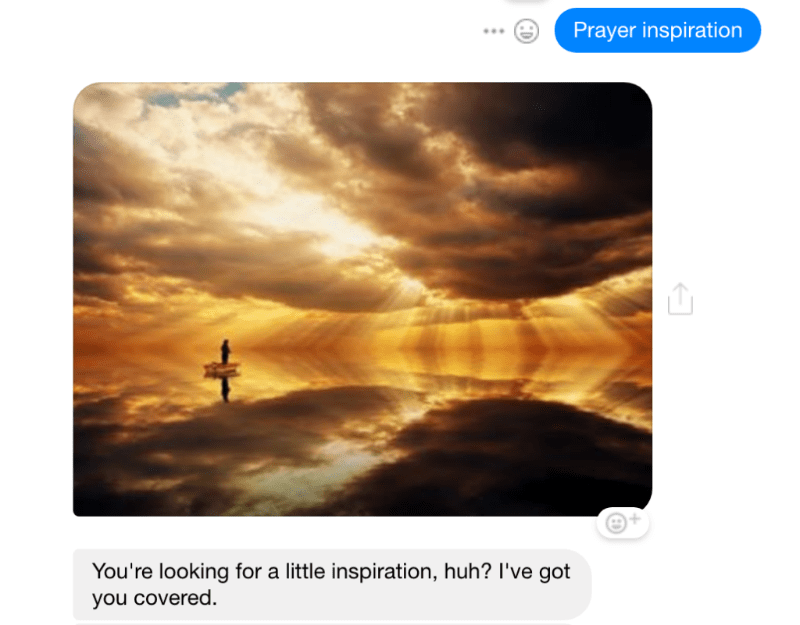A good friend of mine developed a well-known chatbot for a faith-based organization. On a recent skills-exchange fun day, he showed me around the automation tool he uses.
Thus was born CCP Prayer Guide.
As I wrote on Facebook when introducing him to the world,
Please talk to my chatbot. He’s a really dumb spiritual director with a very limited library of multimedia prayer resources and some mostly wonky coaching moves.
He is only a prototype. Don’t send the link to your kid who hasn’t gone to church since high school.
(Yet.)
Seriously, I’m just playing around with this. But I also think it’s a good idea and I’m curious if you do too.
Sufficiently disclaimed? OK: prayr.cc/guide
There followed a generous flurry of engagement and good-natured feedback. Lots of people were curious, a few quite excited, a few understandably disappointed.
It’s been a fun project so far—I actually just uploaded a few behavioral changes in response to that first round of feedback. My favorite: the (very human) request that I code in a way to say goodbye. People felt creepy just leaving the conversation when they lost interest in the loop of options.
**
I’ve long been interested in how we can use the tools that otherwise govern our working or even waking hours to carve out a space for spiritual practice. These offerings don’t have have to be fancy (hi, Pray As You Go!), just something that can remind us to pray and provide some just-in-time resources—maybe a little bit of extra support for people who are new to prayer, or to certain types of it.
When I started my digital missioner job at VTS, one of the first things I did was go on a retreat to see if I could develop from a scratch a “Rule of Life” app.
(Spoiler: I couldn’t, at least not one I found very compelling.)
Every year or so, a group of us rallies around an idea like this: as an app, or maybe a podcast. Here’s the most recent such convening.
There are major challenges. Attractive, full-featured apps are still incredibly expensive to develop. My intel says $80-100K if you don’t want it to look like it was obviously built from a drag-and-drop, third-party kit.
Should the Episcopal Church have done it by now? Maybe.
But I’ve talked to some pretty savvy publishers who think it’s a good way to waste a lot of money. Granted, those publishers are usually trying to run content-sales businesses, whereas for denominations it might just be the cost of doing business. Still, some of the pushback I’ve heard over the years at least gives me pause.
So I gotta say, I’m pretty intrigued by the idea that a chatbot could do much of what I’ve always wanted an app to do: remind me to pray and provide some resources. Among the arguments in favor of the approach are the following:
(1) Most people have messenger apps on their phones. And those apps pretty much have to have notifications set up, since messaging is kind of useless without them.
(2) Chatbot software is really easy to learn. A programming background helps but is definitely not required. You do have to be able to think like a programmer/designer (e.g., “How will users interact with my tool?”), but you don’t have to be able to write code. I think a good chatbot is probably much cheaper to develop than a good app.
(3) Part of what’s fun about interacting with a chatbot is the choose-your-own-adventure feeling. Using a bot as a kind of “interface layer” between users and a library of spiritual resources is that users get to make some choices, but they don’t get overwhelmed.
(4) A chatbot still gives developers access to most of the affordances of a smartphone. You can show someone a picture, play them some audio or video, or chime/vibrate when their two (or five or …) minutes of quiet prayer time are finished.
(5) Writing for a chatbot (unlike for a sermon or blog post) forces you to get right to the point. Ever since a fateful post-confession chat with beloved spiritual teacher Mark Dyer,* my thinking has been that less is more when you’re trying to inspire prayer.
A beautiful image, a short poem, a few verses of scripture, a simple melody repeated like a mantra. In my opinion, we don’t actually need much more than that to point our souls in the right direction.
I don’t know what the next year has in store for me (more from the life changes department very soon), but I hope some more development time on this (playful) proof of (prayerful) concept is in my future.
If you want to hear about the bot’s expanding library and vocabulary, watch the blog and the newsletter—or send literally any message to the CCP Prayer Guide (v. 1.1).
Image credit: rawpixel on Unsplash
* Disclosure: Affiliate link. But I really hope you will read this lovely biography by Tom Linthicum.
